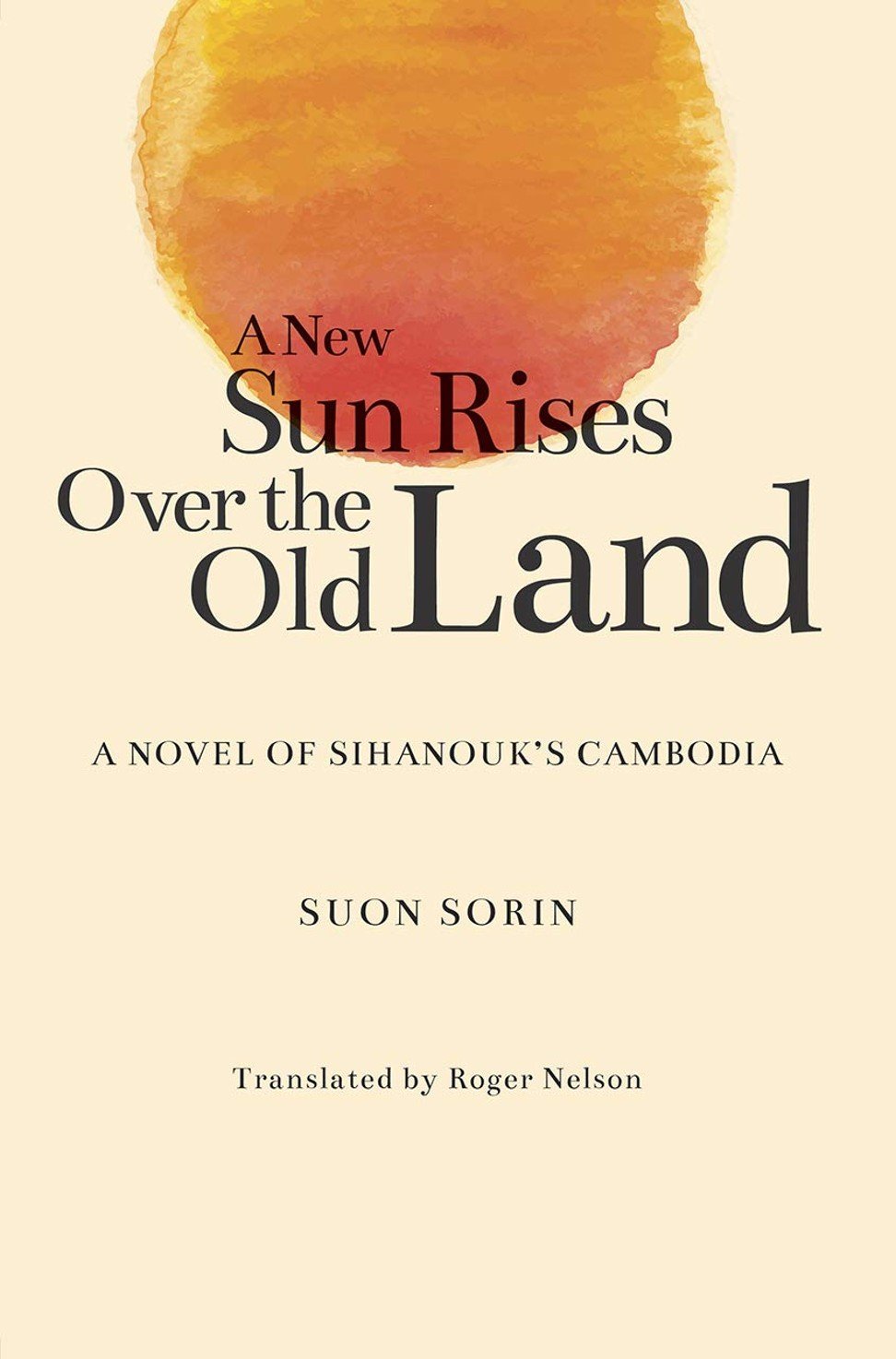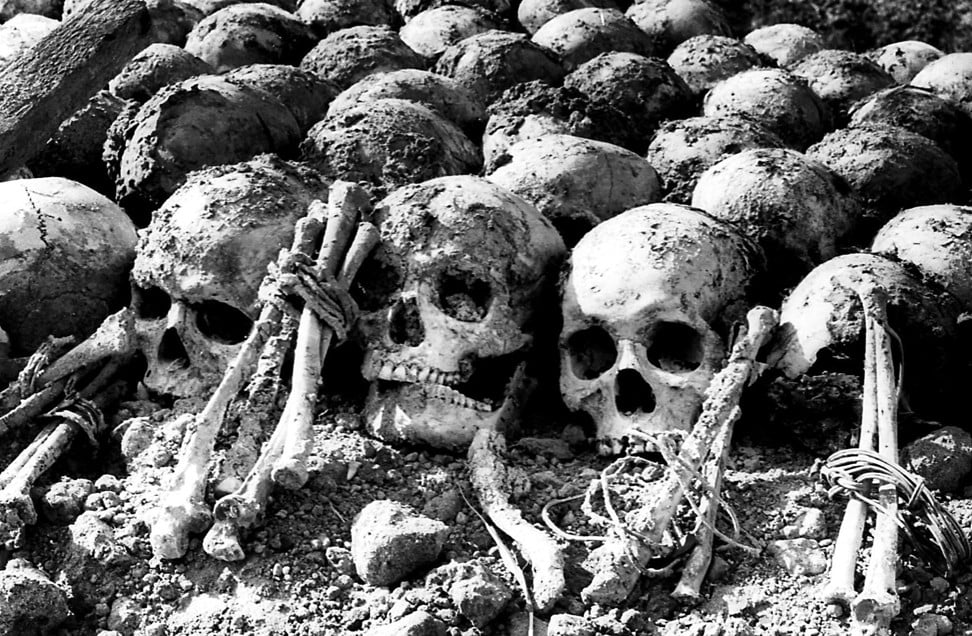‘A New Sun Rises Over the Old Land’, translated into English for the first time, captures the zeitgeist of 1960s Cambodia and its accompanying hope
Seen through the eyes of cyclo driver Sam, it is a call for faith in better days, brought about by the advent of an independent Cambodia
Farah Abdessamad
Published: 1:00pm, 26 Jan, 2020
scmp

Cyclo drivers pedalling past a portrait of Cambodia’s King Norodom Sihanouk and his wife Queen Monineath displayed at the royal palace in Phnom Penh in 1996. Photo: Reuters
A New Sun Rises Over the Old Land: A Novel of Sihanouk’s Cambodia, by Suon Sorin (translated by Roger Nelson). Published by NUS Press. 5/5 stars
A rare and precious glimpse of pre-Khmer Rouge literature, Suon Sorin’s A New Sun Rises Over the Old Land, originally published in 1961, harks back to Cambodia’s late colonial and postcolonial eras under monarch-turned-politician Norodom Sihanouk.
Apart from the conclusion and prologue, in which protagonist Sam, the driver of a cyclo three-wheel bicycle taxi, is on his way to attend a National Congress as a delegate, the entire book is set in flashback. Cambodia’s attainment of independence in 1953 sets a chronological marker of a before and after.
Sam has, with wife Soy, left his conflict-ridden home in northwestern Battambang province for the capital Phnom Penh. His life in the city is one of hardships, which they must navigate. Their daily existence is tested by injustice, poverty, greed and hope.

Sam and Soy’s days take an even darker turn when Sam becomes unable to pay the daily rental fee to the owner of his cyclo. The family’s trajectory quickly spirals downwards as their only source of income is repossessed. They are evicted from their home.
Both the wealthier landlord and cyclo owner show no pity, a recurrent theme. Without enough savings for a deposit, Sam is unable to rent a new cyclo. Coming to terms with the situation, Soy accepts paid work as a domestic servant of a rich trader. This marks the start of a new chapter for Sam and Soy.
The first English-language translation of A New Sun Rises Over the Old Land is both a significant effort in itself and provides an opportunity to widen the readership of a gripping story. Roger Nelson’s formidable feat is testament to a deep respect towards the source material. The prose remains airy, while helpful notes contextualise locations and terminology for readers unfamiliar with Phnom Penh’s history and landscape.

Bearing witness to the brutality of the Khmer Rouge, a pile of skulls rests in a “killing field” outside Phnom Penh in this March 1980 file photo. Photo: AP
The original book won the first Indradevi Literary Competition in 1961 under the auspices of Sihanouk, who was then head of state. Sihanouk’s affection for the arts, cinema above all, is well known; less so, perhaps, is his similarly direct involvement in literary affairs. During the award ceremony in 1961, Sihanouk’s speech expressed a determining view on the role of Cambodian writers, holding “a responsibility not only to literature, but also to nation building”.
Sorin’s story is undeniably anchored in that zeitgeist. It can in many ways be read as a prescriptive tale. His protagonist, Sam, despises the greedy, the selfish, the corrupt. As a cyclo driver, Sam is the epitome of the daily worker sacrificed by his bosses, waking up without knowing where his next meal would come from. His family and close friends honour the traditional values of Khmer society, contrasting their thoughts and actions against Buddhist principles. Sam longs for dignity and respect. Solidarity that transcends class is a heralded ideal in the novel.

Undated photo of Prince Norodom Sihanouk, circa 1970.
A New Sun Over the Old Land is a call for faith in better days, brought about by the advent of an independent Cambodia and Sihanouk’s leadership. When Sam returns to Phnom Penh in 1960, after several years away, he notices tremendous improvements to the city, which he attributes to the Royal Government.
Places of moral depravity have closed; new schools and hospitals have been established, old ones renovated; cars and city lights fill the streets; and a sense of safety, democratic participation and prosperity embalms the capital. The contrast with Sam’s earlier ordeal, under the previous regime, serves the propaganda of Sihanouk’s political party, the Sangkum Reastr Niyum (“community of the common people”).
Sorin’s novel was a bestseller upon its release and remains widely read in contemporary Cambodia. His main character’s aspiration for a good life, guided by ethics, hard work and harmonious relations, echoes Sihanouk’s promise of modernisation, as well as the ambiguity of his tenuous ideological balance between monarchism conservatism and “Buddhist socialism”.
Unfortunately, the author’s life and fate remains blurry … Sorin is assumed to have perished during the Khmer Rouge genocide, along with up to 2 million fellow Cambodians
For many, the Sangkum Reastr Niyum period evokes nostalgia, one of ambitions and transformations, a time before the Khmer Rouge tragedy and its legacy. Founded in 1955 by Sihanouk as he stepped down from the throne in favour of his father, the Sangkum movement dominated Cambodian politics until 1970. Today, one can still observe in Phnom Penh the unique architecture inspired by the Sangkum period, standing side by side with more contemporary high-rise apartment blocks and office buildings sprouting as the city expands.
Yet if Sorin’s novel indeed captures the zeitgeist of the 1960s and its accompanying hope, how did the Khmer Rouge gain power the following decade?
The novel may not have the scope to answer this question but it does provide insights into the deep ethnic and class divides. Sam calls for fairness and justice, as he challenges the notion of economic determinism. He regularly questions the value of integrity when faced with the repeated cunning of those who Sam knows as “capitalists”.

Old buildings in Phnom Penh designed by Cambodian architect Vann Molyvann. Photo: Scott Howes
Sorin highlights Chinese and Vietnamese origins of the capitalist class through their names, and contrasts them with Sam. “It is only the poor who can understand the poor,” Sam tells a friend. City life left him crushed, while the countryside offered prospects and fulfilment.
A narrative which places otherness and mistrust at the centre would later find a ghastly finale, propelled among other factors by the Second Indochina War and economic collapse. Lon Nol’s military regime toppled Sihanouk’s Sangkum movement and ended the monarchy by 1970. The ultimate rise of the Kampuchean Communist Party and the Khmer Rouge catastrophically followed.
Duck soup for the soul: Cambodia chefs are on a food renaissance
13 Mar 2019
Unfortunately, the author’s life and fate remains blurry. This book is his only surviving work. Sorin is assumed to have perished during the Khmer Rouge genocide, along with up to 2 million fellow Cambodians.
A New Sun Over the Old Land is compelling, tackling universal themes and conflicts. Roger Nelson offers an important contribution to the dissemination of pre-1975 Cambodian arts and history.
Asian Review of Books

1 comment:
The root cause of Cambodia's catastrophe stemmed almost totally from Ah Sdach Chkuot Sihanouk's erratic judgment about the Vietnam war.
Instead of keeping Cambodia neutral, Ah Lob Sihanouk took side with the evil
then North Vietnam and let the Vietcong used Cambodia as a sanctuary to attack then south Vietnam, and the war was expanding to Cambodia afterward...
Therefore, Ah Roleuy Sihanouk is not a Maha Vireak Ksat for Khmer people but a Maha Virak Ksat for Yuon because Yuon conquered Cambodia in 1979 as a result of Ah Sihanouk's traitorous act.
Post a Comment